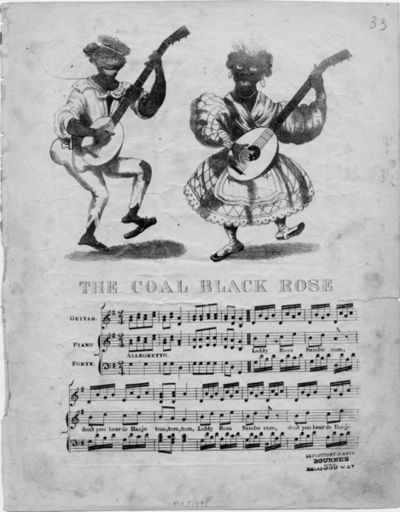Annotation:Coal Black Rose: Difference between revisions
No edit summary |
No edit summary |
||
| Line 1: | Line 1: | ||
---------- | |||
{{TuneAnnotation | |||
|f_tune_annotation_title=https://tunearch.org/wiki/Annotation:Coal_Black_Rose > | |||
|f_annotation='''COAL BLACK ROSE'''. American, Minstrel Air (2/4 time). G Major (Kerr): C Major (Howe). Standard tuning (fiddle). AABB. The song is one of the earliest known blackface minstrel songs, dating from 1820, when it was popularized on stage by George Washington Dixon, followed by Thomas Blakeley and others. A farce, it tells of the fight between Cuffee and Sambo over a woman, a stereotyped comic black love triangle. | |||
---- | |||
---- | |||
'''COAL BLACK ROSE'''. American, Minstrel Air (2/4 time). G Major (Kerr): C Major (Howe). Standard tuning (fiddle). AABB. The song is one of the earliest known blackface minstrel songs, dating from 1820, when it was popularized on stage by George Washington Dixon, followed by Thomas Blakeley and others. A farce, it tells of the fight between Cuffee and Sambo over a woman, a stereotyped comic black love triangle. | |||
[[File:coalblack.jpg|400px|thumb|left|Coal Black Rose songsheet, c. 1827]] | [[File:coalblack.jpg|400px|thumb|left|Coal Black Rose songsheet, c. 1827]] | ||
|f_source_for_notated_version= | |||
|f_printed_sources=Gumbo Chaff ('''The Complete Preceptor for the Banjo'''), 1851, p. 8. Elias Howe ('''Second Part of the Musician’s Companion'''), 1843; p. 57. Howe ('''Complete Preceptor for the Accordeon'''), 1843; p. 18. Kerr ('''Merry Melodies, vol. 3'''), c. 1880's; No. 294, p. 43. | |||
|f_recorded_sources= | |||
|f_see_also_listing= | |||
}} | |||
------------- | |||
---- | |||
Latest revision as of 18:46, 31 January 2021
X:1 T:Coal Black Rose M:2/4 L:1/8 R:Minstrel Tune B:Elias Howe – Second Part of the Musician’s Companion (1843, p. 57) Z:AK/Fiddler’s Companion K:G Bdce|Bd A2|Bdce |dF G2:||:B2c2|BA G2| B/B/B/B/ ce|dF G2|B2c2 |BA G2|B/B/B/B/ ce|dF G2:|
COAL BLACK ROSE. American, Minstrel Air (2/4 time). G Major (Kerr): C Major (Howe). Standard tuning (fiddle). AABB. The song is one of the earliest known blackface minstrel songs, dating from 1820, when it was popularized on stage by George Washington Dixon, followed by Thomas Blakeley and others. A farce, it tells of the fight between Cuffee and Sambo over a woman, a stereotyped comic black love triangle.


